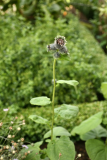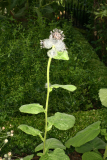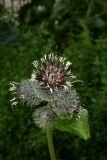Additional notes (click to expand)
Commemorative
Henrich Benedict de Saussure (1740-1799) Swiss philosopher and scientist, professor of Philosophy in Geneva, pioneer of botany of the high Alps. Climbed Mont Blanc in 1787 (first climbed by Paccard and Balmat with his encouragement in 1786)
Stearn, W.T. (1996). Dictionary of Plant Names for Gardeners. Cassell.
It was described first as Aucklandia costus by Dr Hugh Falconer, Superintendent of the Calcutta Botanic Gardens, in 1841. He found it on a journey to Kashmir under the auspices of Lord Auckland, Governor General of India at the time, and named it in his honour.
Annals of Magazine of Natural History vol 6 (1841) page 474-475 https://www.biodiversitylibrary.org/bibliography/15774#/summary
Horticulture
An erect, robust, pubescent, perennial herb, with a stout simple stem 1–2m high. Leaves membranous, scaberulous above, glabrate beneath, auricled at base, irregularly toothed; basal ones very large, 0.50–1.25m long, with a long winged petiole; upper leaves smaller, subsessile or shortly petioled; two small lobes at the base of these leaves almost clasping the stem. Flower heads stalkless, bluish-purple to almost black, hard, rounded, 2.4–3.9 cm across, often 2–5 clustered together in the axils of leaves or terminal. Involucral bracts many, ovate-lanceolate, long pointed, purple, rigid, hairless. Receptacle bristles very long. Corolla about 2cm long, tubular, blue-purple or almost black. Anther tails fimbriate. Achenes curved, compressed ca. 8mm long, tip narrowed, with one rib on each face. Pappus brown, double feathery. Roots are stout, dark brown or grey, up to 40 cm long.
Pandey, M. M., Rastogi, S. Kumar, A., Rawat, S. 2007. Saussurea costus: Botanical, chemical and pharmacological review of an ayurvedic medicinal plant, Journal of Ethno-Pharmacology [online] 110. http://www2.ups.edu/faculty/bdasher/Chem361/Review_Articles_files/aryvedic%20plant.pdf
link
Sow dry, ripe seed in a cold frame in spring. Surface sow, or only just cover the seed, and make sure that the compost does not dry out. Prick out the seedlings into individual pots when they are large enough to handle and grow them on in the greenhouse or cold frame for their first winter. Plant out in late spring after the last expected frosts. It succeeds in most soils in a sunny well-drained position.
Divide established clumps in spring.
Medicinal
In Traditional Chinese Medicine the root is decocted with other herbs for abdominal pain, asthma, cancer, cholera, gas, nausea, rheumatism, stomach ache, tenesmus, tympanites, uterine contractions, carminative, cough, diarrhea, dysentery, dyspepsia, stimulant, stomachic, tonic and vermifuge. Saussurea costus is cultivated in Szechuan, Yunnan.
Duke, J. A. & Ayensu, E. S., 1985. Medicinal Plants of China. Vol. 1, Reference Publications, Inc. Michigan p.178
The root is the only part of the plant that is used medicinally. It's well known in both Ayurvedic and Tibi medicine. The root contains the alkaloid saussurine and it's reputed to help strengthen digestion, cleanse the body of toxic accumulations, act as an aphrodisiac and antiseptic. It's commonly used for spasmodic diseases, like bronchial asthma, cough and persistent hiccup; as a stomachic and tonic it's given in advanced stages of typhous fever; as a stimulant in cholera; and to treat chronic skin diseases and rheumatism. Externally the root is used as an ointment or powder to treat ulcers and maggot infested wounds.
Dastur, JF. (). Medicinal Plants of India & Pakistan, DB Taraporevala Sons & Co. Ltd.1st ed. p.208
Traditional Herbal Medicine Registration (THMR).
Nomenclature
Costus comes from the Latin for an aromatic oriental plant called costum which is a transliteration from the Greek for the same plant. Its use, under this name, is to be found in Pliny and Horace ‘frequently used for the preparation of costly unguents’. It was described first as Aucklandia costus by Dr Hugh Falconer, Superintendent of the Calcutta Botanic Gardens, in 1841. He found it on a journey to Kashmir under the auspices of Lord Auckland, Governor General of India at the time, and named it in his honour. He noted both its resemblance to plants in the genus Saussurea (which had been described in 1841) and that it was ‘the long-disputed Costus of the ancients, and …[fitted] … the description given by Dioscorides’. He reported that it was an important item in Kashmir trade, as koot, a homonym for the Arabic name, Koost [q.v. Costus, kuth, kust]; that it grew in great abundance in the valley of Kashmir at 8,000 to 9,000 feet and that two million pounds in weight of the roots were collected every year and sent to China where it was highly valued as ‘an aphrodisiac and for incense’. The Kashmir price was 2s 4d (11p) per pound and in Canton £2 5s 7d (£2.25p). In Kashmir they used it to protect wool shawls from moths and hung round the necks of children to protect them from the ‘evil eye’. Unsurprisingly, it is now endangered in the wild and is being widely cultivated around the world for its herbal uses.
Annals of Magazine of Natural History vol 6 (1841) page 474-475 https://www.biodiversitylibrary.org/bibliography/15774#/summary
Previously grown as Saussurea costus
Plants of the World online, Kew Science http://www.plantsoftheworldonline.org/taxon/urn:lsid:ipni.org:names:60441917-2
link
Synonym of Dolomiaea costus.
Plants of the World online, Kew Science https://powo.science.kew.org/taxon/urn:lsid:ipni.org:names:77210782-1
link
Other use
The fragrant root yields a volatile oil used in scent for its strong, lingering perfume and for preserving furs.
Pandey, M. M., Rastogi, S. Kumar, A., Rawat, S. 2007. Saussurea costus: Botanical, chemical and pharmacological review of an ayurvedic medicinal plant, Journal of Ethno-Pharmacology [online] 110. http://www2.ups.edu/faculty/bdasher/Chem361/Review_Articles_files/aryvedic%20plant.pdf
link
Phytochemistry
At least 70 substances with various biological activities in laboratory experiments have been isolated from the plant including anthraquinones, alkaloids, flavonoid glycosides, phenylpropanoids and terpenes (Rao, Babu and Ramnareddy, 2007; Madhuri, Elankar and Ponnusankar, 2012; Zahara et al, 2014; Chik et al, 2015). The more important specific terpenes include costunolide and its derivatives and various costus lactones; they are important in its biological activities. The sesquiterpenes, which are responsible for much of the aroma and flavour, include ionone, bergamotene and cymene compounds (Maurer and Grieder, 1977). (Pers.comm A.Dayan)
Geographical distribution
- Asia-Tropical, Indian Subcontinent, India
- Asia-Tropical, Indian Subcontinent, Pakistan
Podcast
Aucklandia costus Falc.
Family: ASTERACEAEGenus: Aucklandia
Species: costus Falc.
Common names: Costus, Kushta, Kuth, Koshet
Pharmacopoeia Londinensis name: Costus
Distribution summary: India, Pakistan
Conservation status (IUCN Red List): Critically Endangered
Habit: Perennial
Hardiness: H7 - Very hardy
Habitat: 2000 - 3300m in irrigated areas, damp shade in Kashmir, ground cover in birch forest
Garden status: Not currently grown
Flowering months: July, August
Reason for growing: Commemorative, medicinal, other use, traditional herbal registration




